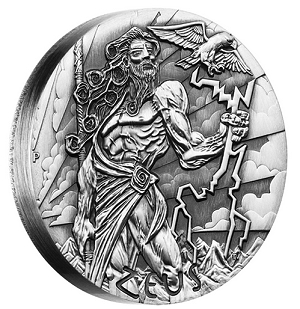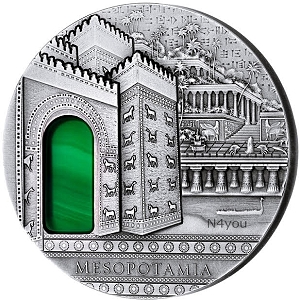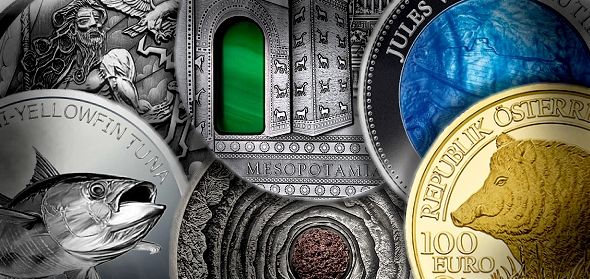 By Louis Golino for CoinWeek….
By Louis Golino for CoinWeek….
So many countries are issuing so many numismatic coins today that collectors in this field need to be more selective than ever about what they buy and collect. Just compare the number of pages in the 2015 edition of Krause Publications’ Standard Catalog of World Coins, 2001- present with the same book from three years ago, which is almost twice the size of the earlier edition, and it is easy to see how saturated the world coin scene has become.
Certain modern world coins such as the Tiffany Art series are always in demand because of their exquisite detail and high quality, which when combined with a limited run, have driven their strong performance in the marketplace, but many others quickly depreciate not long after they are issued as interest in them fades. Modern world coins should not be seen as an investment, but since no one enjoys seeing their coins depreciate it is useful to review some key trends in modern world issues from the past year with the intention of trying to determine which issues tended to be more successful and are more likely to at least hold their value. I will focus on what I would call high-end luxury issues.
One important trend that become more pronounced in 2014 is the proliferation of higher-end world silver coins minted in larger sizes and featuring increasingly innovative concepts such as the cylinder-shaped Fortuna Redux coins from the Polish Mint, coins with holograms and crystals, and so forth. The past year has given collectors who can afford to spend from $200-300 and up per coin some of the most beautiful and distinctive coins ever released.
As this type of coin has become more common, it has become essential for each coin to have distinctive and unique features that separate it from the pack. For example, dome-shaped coins remain very popular with collectors because there are still relatively few of them. But as their numbers continue to grow, each one must have something special and different about it to be a hit with collectors.
Two recent examples of dome-shaped coins are the 2014 International Cricket Council coin issued by the Royal Australian Mint, which is an elegant coin with large, clean fields, and the 2014 Erta Ale Volcano coin with real lava issued by the Mint of Poland for Niue, which I covered recently , and which is very impressive in hand. In addition, buyers tend to prefer coins with a more pronounced degree of curve from those with less of a curve.
My personal 2014 higher-end world coin favorite is the 5-ounce high relief silver proof 2014 Britannia coin that features a stunning Art Deco depiction of this iconic British image and comes in the most impressive display case I have ever seen for a silver coin. They sold out of their limited mintage of 600 units fairly quickly and have increased by approximately 50% over their issue price of about $500.
Dealer exclusive modern world coins have become much more prevalent in the past year for both bullion and collectors issues. Hayden Tubbs, Vice President of ModernCoinMart defined these coins in a recent article in American Hard Assets magazine this way: “… an exclusive world coin is a custom issue designed and facilitated by a private company with exclusive rights to distribute the coins worldwide. These coins are usually minted by an established world mint using the effigy of another country.” Numerous such coins have been issued by both established world mints like the Mint of Poland, which mints many special collector coins for other countries and private companies, and by private mints such as B.H. Mayer in Germany, as Mr. Tubbs noted in his piece.
 A new custom dealer series from APMEX and the Scottsdale Mint depicting scenes from the bible was launched in mid-December. The first coin is called Exodus, depicting a design that was “inspired by Gustave Doré’s illustration of “The Egyptians Drowned in the Red Sea,” showing Egyptians and their horses in chaos as the Red Sea overtakes them. In the distance, Moses and the Israelites stand atop a hill, safe from the water,” according to the APMEX web site.
A new custom dealer series from APMEX and the Scottsdale Mint depicting scenes from the bible was launched in mid-December. The first coin is called Exodus, depicting a design that was “inspired by Gustave Doré’s illustration of “The Egyptians Drowned in the Red Sea,” showing Egyptians and their horses in chaos as the Red Sea overtakes them. In the distance, Moses and the Israelites stand atop a hill, safe from the water,” according to the APMEX web site.
This series was clearly inspired by the Perth Mint’s very popular three-coin Gods of Olympus series, and it uses the same basic format. A rimless, high relief coin made of two ounces of silver with an antique finish that has the diameter of a one-ounce coin with the extra weight in the coin’s thickness. The coins even have the same mintage as the Perth coins, 1500, or more precisely 1499. They are also numbered on the edge, which collectors like, and which the Perth coins are not.
There will six new coins a year in this series for a decade. At almost $180 a coin currently, that is an $11,000 or more commitment to complete the series, something few collectors are likely to be willing or able to do given all the other coins competing for their attention and money, though they may just purchase the ones that appeal the most to them. It is telling that the Exodus coin did not sell out instantly like the Perth issues did, though it did sell all but about 120 coins in two weeks.
The Gods of Olympus Perth series was a major highlight of the year and one of the best appreciating world coin series from 2014. That was a result of very unusual designs that combined a modern representation with an ancient theme, and because only three coins are needed for the series. Huge global demand and the difficulty of obtaining these coins at issue price was a recipe for very rapid appreciation with the Poseidon and Hades coins quickly doubling in value, and the first issue for Zeus reaching as much as $1,000 a coin in some sales from an issue price of about $170 in just a few months. Currently the Zeus is bringing an average of about $500 in online auctions, and the other two have settled to the low $300’s – all well over issue prices.
 Another successful 2014 coin is the Niue Mesopotamia coin, the first in an eight year series called Imperial Art that will depict the art and architecture of the world’s eight major ancient empires and civilizations and which includes an insert made of agate that is reminiscent of the crystals in the Tiffany coins. For the first coin which depicts the famous Hanging Gardens of Babylon in present-day Iraq green-colored agate was used to represent the rich vegetation of that area at the time of the Babylonian, Assyrian, and related empires. Each of these coins is numbered on the coin’s edge and certificate, is made of two ounces of silver, and the mintage is limited to 500 pieces, which quickly sold out during pre-order, keeping the retail price firmly in the high $300’s to $400 range.
Another successful 2014 coin is the Niue Mesopotamia coin, the first in an eight year series called Imperial Art that will depict the art and architecture of the world’s eight major ancient empires and civilizations and which includes an insert made of agate that is reminiscent of the crystals in the Tiffany coins. For the first coin which depicts the famous Hanging Gardens of Babylon in present-day Iraq green-colored agate was used to represent the rich vegetation of that area at the time of the Babylonian, Assyrian, and related empires. Each of these coins is numbered on the coin’s edge and certificate, is made of two ounces of silver, and the mintage is limited to 500 pieces, which quickly sold out during pre-order, keeping the retail price firmly in the high $300’s to $400 range.
The production of this coin was delayed by the Mint of Poland, but the coins have arrived in Europe, and are expected in the U.S. at First Coin Company, which is the exclusive U.S. distributor, in early January. I expect them to continue to do well because the design is beautifully executed, and they tap into the interests of coin collectors in art, history, and architecture, and there will only be one coin per year, which will allow more people to buy the entire 8-coin series.
One other highlight of the year is a coin that brings together classic art masterpieces with highly advanced modern technology. It is the Cook Islands Last Judgment coin, the third in the Ceilings of Heaven oval-shaped silver proof coin series, struck in high relief and with an antique silver finish and mintage of 999 coins. What makes the coin really unique is an octagonal nano chip in the coin’s center which when viewed with a microscope allows one to see a high resolution image of the entire Last Judgment fresco that is in the Florence Cathedral, one of the most famous art works in the world that was painted by Giorgio Vasari and collaborators. First Coin Company is also the exclusive American distributor for this coin, which was the brainchild of Italian dealer, Powercoin, and provides a free microscope to buyers of the coin.
These are just a few examples of some of the major trends in the modern world coin scene and some of the better coins from 2014. Because the appeal of particular designs is such a subjective issue, there will never be one specific formula for success. But the fact remains modern collectors tend to agree to a great extent on what constitutes a well-executed and original design and a compelling theme. If the coin has a very limited mintage preferably under 1,000, is individually numbered at least on the certificate and preferably on the coin, and has certain distinctive features in its theme or concept, that tends to be a winning recipe.
I am sure 2015 will bring even more interesting new world issues, and I look forward to covering these for the readers of this column.
Updated to attribute the correct description of APMEX’s biblical coin design.






I’m not a fan at all for these higher end “coins.” When rocks, gems, whatever, are added to the coins, they seem to become something else entirely. One could argue even that proof coins weren’t meant to circulate, and you sometimes hear people bypassing these for coins that actually circulated. I can understand this. With these luxury coins, they seem to have to do more with art than anything else. Sure, since they’re issued from a gov’t mint or one recognized by a gov’t and have a face value, they are technically coins, but everything else tells you they are in fact not. Whatever floats one’s boat though
Joe- Thanks for your comments. I have always said this is a subjective matter and stressed that such coins are best seen as art to be enjoyed by those who like them. I have also several times noted that some people, including many American dealers and collectors, do not believe non-circulating legal tender world commems are really coins, but the fact is this is a growing segment of the market both here in the U.S. and around the world. And if it were true they are not coins, then the same would be true of American commems. So if something is issued under a country’s legal authority, it is coin. Finally, not all of the coins covered use color and unusual shapes, etc. like the Britannia proofs and the Gods of Olympus series, two of my personal 2014 favorites.
Louis, I really feel the need to call attention to a little none piece of written history which is stated incorrectly in your article, I of course am being sarcastic, but I just can’t let it slide.
I’m referring to the APMEX and Scottsdale Mint new custom dealer series coin…
The actual description from the APMEX website is:
“features an image of Gustave Doré’s “The Egyptians Drowned in the Red Sea,” a compelling rendering of the artist’s famous work.”
I’m pretty sure the ancient wording isn’t “the Israelites accompanying Moses drowned in the Red Sea.”
Thanks, Dusty. You are correct.